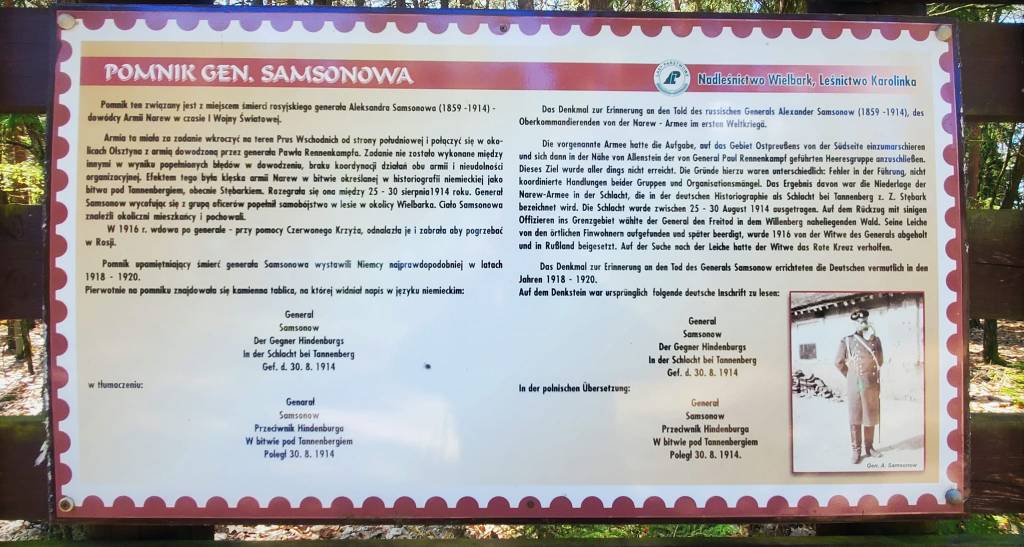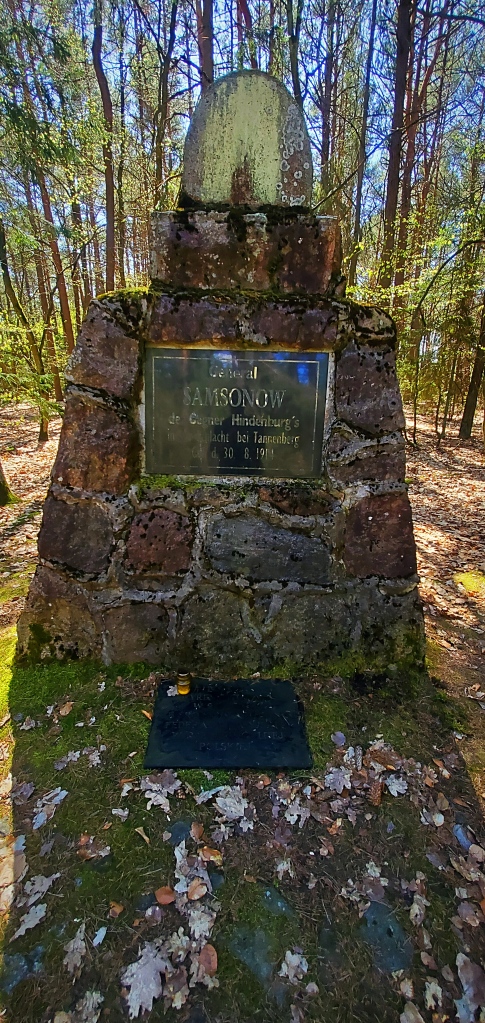“There it is!”
“Where?”
“We just passed it”.
The phrase, “blink and you’ll miss it” comes to mind concerning the moment we finally found the Samsonov Monument. My travel companion first noticed the monument when I had already driven past it. Even though I was only driving 50 kph down the dirt road, the monument was not easy to see. Fortunately, my friend happened to glance out of the corner of his eye and catch a glimpse of the monument. I never saw it until he said something. Quickly glancing back over my shoulder, I saw the monument just off the road tucked into the surrounding forest. I quickly put the car in reverse. After 50 meters we were right in front of the long -awaited goal. This was the point when a decade and a half journey successfully concluded at the long-awaited destination.

Up close & personal – My friend & the Samsonov Monument
Flaming Out – A Change In Fortunes
The Samsonov Monument stood alone in a small clearing by the roadside. The monument was a pyramid shaped stone structure with an embossed plaque on the front with Samsonov’s name and date of death. The plaque was shiny, looked relatively new, and clearly legible. In front of the monument was a single glass cemetery candle. Around the back were several more. Commemoration still occurred at the monument, but I wondered by whom. Wicks on the glass candles had burnt out long ago. The containers holding them did not look very old. Anonymous individuals were keeping the flame of Samsonov’s fatal moment alive. The history here simmered in obscurity
The Russian Empire disintegrated in 1917. The German Empire a year later. This ground had been part of Poland since then, except for the Nazi occupation during World War II. Of course, Russian nationalism had been back on the march in Eastern Europe since Vladimir Putin came to power at the start of the 21st century. That was until Ukraine stopped Russian revanchism. Ironically, Samsonov was born in Kherson, a city that has been in the crosshairs of the fighting since Russia’s unprovoked invasion of Ukraine started. Now Russian nationalism is in retreat, just as it was after Samsonov’s suicide, and the Tsarist Army’s devastating defeat at Tannenberg. History does not repeat, it rhymes.
The Samsonov Monument was erected by the Germans after the war. They were looking for sites to glorify from their crushing victory over Russian forces at the Battle of Tannenberg. This would provide some solace for the grievous wound to their pride from losing the war. The Germans were able to identify where Samsonov shot himself by its proximity to where his body was discovered and exhumed. His remains were transported by railway to neutral Denmark and then shipped back to Russia. Samsonov ended up buried in the family plot back home. This was a long way from the final tragic act of his life. The monument was the only thing left about Samsonov still located on the field of battle. Proof that even the most important actors in military history often end up vanishing from the field of battle.
Burning the candle at both ends – The Samsonov Monument
Complex Natures – Matters of Interpretation
Despite its obscurity, the Samsonov Monument still had good information for visitors with two signboards explaining why the “Samsonov Memorial Stone” stood in this location. Calling the monument, a stone downplayed its size and importance. I prefer to call the Samsonov Memorial Stone, the Samsonov Monument because of its substantial size. The monument rises to eight feet in height. Its staying power is a direct result of the construction materials. Moving it would have been costly and labor intensive. Thus, it was never worth the bother.
Because of its remote location, the monument has escaped attention and destruction. Many German memorials in East Prussia were destroyed during the the Red Army’s campaign through the area near the end of World War II. The Samsonov Monument was unique because though it was originally installed by the Germans, it memorialized by a Russian general. This may have helped it avoid wartime destruction. The general’s ethnicity did play a part in its refurbishment. The current information plaque attached to the front was installed in the 1990’s as a replacement for the original. The Russian Federation paid to have it replaced.
In the wake of Russia’s unprovoked invasion of Ukraine, it will be interesting to see whether anything happens to the monument. History in Eastern Europe is often contradictory and extremely complex. The Samsonov Monument reflects that complexity. Because of the monument’s relatively remote location it is likely to remain. For those Poles who are aware of the monument’s existence, I doubt that there are many living in the former lands of East Prussia who give much thought to it. Those who do may see it as more of a curiosity, an artifact from a bygone battle in an age that seems well out of reach.

Matters of Interpretation – One of the signboards at the Samsonov Monument
Space & Time – The Path Back
For me, the most fascinating aspect of the Samsonov Monument is where it stands in space and time. The monument acts as a sort of crypto-historical GPS system leading back to the final days of August 1914. The forests around the monument have hardly changed since the war. The area was never heavily populated and remains that way today. It is not hard to imagine Samsonov stumbling through the woods in the darkness of night, unable to extricate himself or the army he commanded from a disaster that unfolded in a matter of days. His turn in fortunes was so rapid that it is still startling. Samsonov first set foot in East Prussia on August 21st, nine days later he was dead by his own hand.
Russian forces from the 2nd Army had taken Wielbark (Willenburg) just a week before their commander put a gun to his head in the woods west of town. Samsonov was filled with shame over what had occurred and his role in it. Nothing in Samsonov’s experience prepared him for the battle or its result. He had never commanded anything larger than a calvary division. Major-General Alfred Knox, the British military attache to Tsarist Russia, had met Samsonov before the war. He described him as, “simple and kindly.” These were admirable qualities, but not very useful when leading an army against a well-organized and technologically proficient enemy. At Tannenberg, Samsonov lost everything, including his life. Standing before the monument it was hard to believe that anyone would have wanted to memorialize his death.
Coming soon: Silence, Shadows & A Single Shot (Searching For The Suicide Of Alexander Samsonov Part 10)

